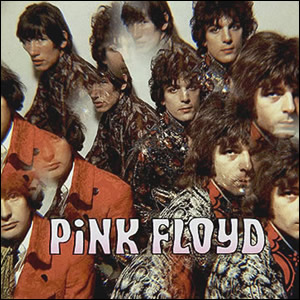Pink Floyd Piper at the Gates of Dawn Review
Buy The Piper At the Gates of Dawn
 The Piper At the Gates of Dawn is the legendary debut anthology by Pink Floyd and the only album during their Syd Barrett-led era. This era began during the summer of 1965, when Barrett joined the established band which included his childhood friend Roger Waters and unilaterally began to telephone call this band "The Pink Floyd Sound", after a couple of obscure dejection men he had in his record drove. By 1966, the band became part of London's "underground" scene, gained some loftier connections, and played some high profile gigs attended by celebrities. In early 1967, the ring signed with EMI and their debut anthology was recorded at Abbey Road Studios with producer Norman Smith. The sessions had their share of turmoil equally Barrett was unresponsive to direction and constructive criticism.
The Piper At the Gates of Dawn is the legendary debut anthology by Pink Floyd and the only album during their Syd Barrett-led era. This era began during the summer of 1965, when Barrett joined the established band which included his childhood friend Roger Waters and unilaterally began to telephone call this band "The Pink Floyd Sound", after a couple of obscure dejection men he had in his record drove. By 1966, the band became part of London's "underground" scene, gained some loftier connections, and played some high profile gigs attended by celebrities. In early 1967, the ring signed with EMI and their debut anthology was recorded at Abbey Road Studios with producer Norman Smith. The sessions had their share of turmoil equally Barrett was unresponsive to direction and constructive criticism.
The sessions for The Piper At the Gates of Dawn came during the middle of a turbulent, exciting, and productive year for Pinkish Floyd, which besides saw the release and charting of three non-album singles. "See Emily Play" was the highest charting on these early on singles every bit the follow-upwards to "Arnold Layne", a controversial song every bit information technology depicted a transvestite whose principal pastime was stealing women's clothes and undergarments from washing lines and many English radio stations refused to play the song.
Knowing the ring's reputation for long and improvised alive renditions, EMI gave Smith and the band gratis reign to create the album they wanted to make. There is a certain genius to this album which may take a lot of work for mainstream audiences to "become". At just the age of 24, Barrett reached within and tapped into a psychological earth caught between the wondrous discoveries of babyhood and the tragic revelations of a finite life. The as well captures both the pleasure and madness of psychedelic music, all the more than compelling in light of Barrett's subsequent breakdown and deterioration which would force him out of the band within a year.
The anthology too contains many philosophical and intellectual elements, including information technology's championship, which Barret took from Kenneth Grahame's book The Wind In the Willows. Although the compositions are genius, in that location are some flaws in the production as the overall mix is a bit bright and the bass is woefully under-represented throughout. Still, the production is fine plenty for the musical quality to polish through, especially for the seasoned listener.
 The Piper At the Gates of Dawn by Pink Floyd | |
|---|---|
| Released: August 4, 1967 (Capitol/EMI) Produced by: Norman Smith Recorded: EMI Studios, London, February – July 1967 | |
| Side One | Side 2 |
| Astronomy Domine Match Sam Matilda Female parent Flaming Pow R Toc H Take Up Thy Stethoscope and Walk | Intersteller Overdrive The Gnome Chapter 24 The Scarecrow Cycle |
| Tracks On Alternating Album Versions | |
| Arnold Layne Candy and a Currant Bun See Emily Play Apples and Oranges Paintbox | |
| Primary Musicians | |
| Syd Barrett – Guitars, Lead Vocals Richard Wright – Pianoforte, Organ, Vocals Roger Waters – Bass, Vocals Nick Mason – Drums, Percussion | |
The anthology begins with "Astronomy Domine", the ultimate infinite odyssey song with wild tremolo effects and a chanting vocal duet between Barrett and keyboardist Richard Wright. There is an extended instrumental department afterwards first poetry sequence before the song returns for the final sequence. the riff-driven "Lucifer Sam" follows with a cool, mid-sixties British groove, making the song a lot less psychedelic than those on the rest of the album.
"Matilda Female parent" begins with some interplay between Waters' bass and Wright'southward organ, who plays a large office in the song past also taking on lead vocals. At that place are also some fine harmonies during the verses and a slow carousel-similar sequence through the finish. "Flaming" is another melody-driven song but with wild sound effects throughout besides as a vivid acoustic guitar, overdubbed in the 3rd and fourth verses and an odd, nonetheless melodic middle suspension. "Pow R. Toc H." is the first of two instrumentals on the anthology, with the middle of the song driven mainly by a dejection riff (ane of the few moments where Waters bass is well represented). This is a great early art piece by Pink Floyd, though there are times when the audio effects are just a tad overwhelming. Co-ordinate to drummer Nick Mason, the band members were nowadays at Abbey Road when they watched The Beatles recording "Lovely Rita" for Sgt. Pepper's Lonely Hearts Club Band and decided to try voice effects and noises like for "Pw R. Toc H."

Barrett wrote viii of the album's eleven songs along with contributing to 2 instrumentals which were credited to the whole band. Waters was credited with one composition, "Take Up Thy Stethoscope and Walk". This closer of the first side is a more frenzied piece than annihilation else on the album, with Mason actually shines on this track with a style of over-the-top drumming which should make Keith Moon proud. Rumor has information technology that the band insisted in contract negotiations that "Interstellar Overdrive" remain in experimental grade on the debut album. The song, which became the the unofficial theme song of the underground consequence "the fourteen hour technicolor dream", was the beginning recorded by the band in January. This instrumental starts strong, with a stiff and catchy primary riff, simply within a minute and a half the song begins to deteriorate into a psychedelic collage of sound furnishings, which goes on for almost seven minutes and may take be only a scrap much for any sober listener.
Barrett takes over the rest of the album, with some fine and interesting compositions. "The Gnome" is an upbeat, acoustic folk song with some exaggerated vocals by Barrett and some excellent bass by Waters. "Chapter 24" is perhaps the offset deeply philosophical song past a band that would make their reputation exploring such matters. Barrett's melody floats above the transcending musical motif with the middle part dissolving with a Heart-Eastern sounding organ. The vocal was inspired past by text from chapter 24 of the ancient Chinese script I Ching (The Book of Changes).
"The Scarecrow" is built on a series of percussive effects by Stonemason and organ flights by Wright. These at first sound disparate, only are soon held together by layered vocals in concert with tightly strummed electric guitars. An acoustic montage is later overdubbed over the whole ensemble in the outro.

"Bike" is the about brilliant and chilling vocal on the album, and mayhap the quintessential Syd Barrett song. Lyrically, the vocal is metered like a 10-yr-old's boasting bluster nigh disparate subjects during the verse and a melancholy chorus about a "girl who fits in with my earth". Knowing of Barrett'south eventual mental demise, the song has turned out to exist extremely profound. Musically, the song is driven past good piano and effects by Wright throughout and rock driven rock verses with softer, melodic choruses through the song proper, which lasts less than two minutes. The song and anthology concludes with a psychedelic reprise of sound collages.
After the release of the anthology in Baronial 1967, Pink Floyd connected to perform in London, cartoon ever larger crowds. But Barrett's mental land connected to deteriorate and soon he got to the indicate where he could non perform onstage. Aside from a few more than single tracks and one vocal on the next album, A Saucerful of Secrets, Barrett would not perform with the band over again, making The Piper At the Gates of Dawn, a truly unique piece of work.
~

Part of Classic Stone Review's celebration of 1967 albums.
Source: https://www.classicrockreview.com/2012/07/1967-pink-floyd-piper/
0 Response to "Pink Floyd Piper at the Gates of Dawn Review"
Post a Comment